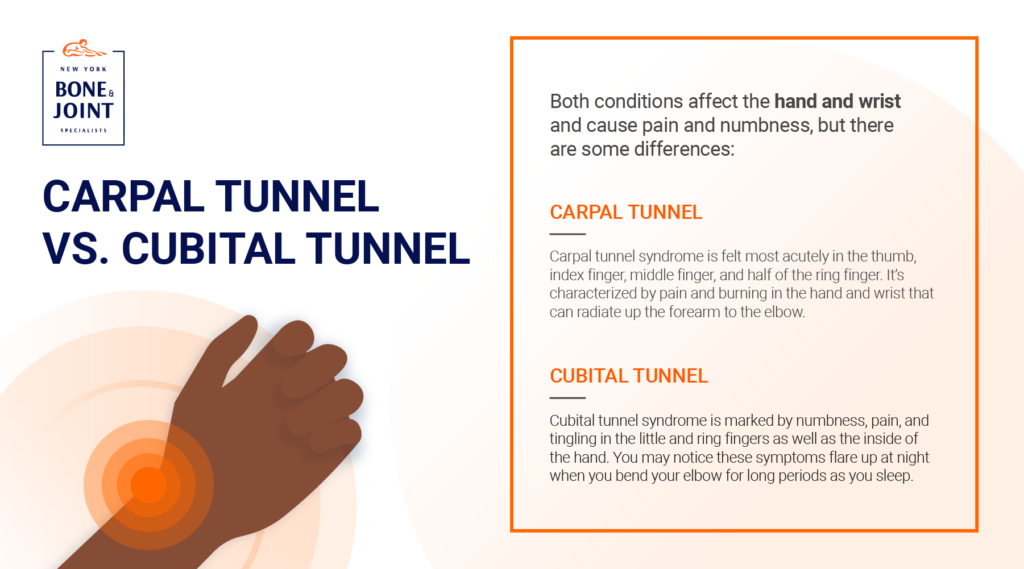Carpal tunnel syndrome and cubital tunnel syndrome share similar symptoms, but they are distinct conditions affecting different nerves in the elbow and wrist.
If you’re experiencing pain and numbness in your fingers, you may assume you have carpal tunnel syndrome. But did you know another condition — called cubital tunnel syndrome — could also be the source of these symptoms?
Both carpal tunnel syndrome and cubital tunnel syndrome result from nerve compression; however, the damaged nerve for each is located in a different part of the body. In cubital tunnel syndrome, the ulnar nerve within the elbow becomes compressed due to injury or repeated bending of the elbow. The ulnar nerve sits inside the cubital tunnel, a passageway consisting of bone, muscle, and ligaments.
On the other hand, the compressed nerve causing carpal tunnel syndrome is the median nerve in the wrist. Repetitive motions of the hand and wrist (such as typing), fractures, and sprains are typically to blame. In addition, chronic conditions such as diabetes and arthritis are considered risk factors for carpal tunnel syndrome.
Despite some similarities — compressed nerves, hand pain, weakness when gripping objects — cubital tunnel syndrome and carpal tunnel syndrome are characterized by several differences. Knowing the symptoms for each can help you identify which condition you may have and determine the right treatment.
Carpal Tunnel vs. Cubital Tunnel
Both syndromes affect the hand and fingers, but the pain, tingling, and numbness of carpal tunnel syndrome is felt most acutely in the thumb, index finger, middle finger, and half of the ring finger. It’s also characterized by pain and burning in the hand and wrist that sometimes radiates up the forearm to the elbow.
Meanwhile, cubital tunnel syndrome is marked by numbness, pain, and tingling in the little and ring fingers as well as the inside of the hand. If you have cubital tunnel syndrome, you may notice these symptoms flare up at night when you bend your elbow for long periods as you sleep.
Diagnosing cubital tunnel syndrome or carpal tunnel syndrome begins with a physical examination. An orthopedist may also perform a nerve conduction study to assess nerve impulses in the wrist or elbow. Weak nerve activity in a certain area could indicate, for example, carpal tunnel syndrome.

Treating the Symptoms
Treatment options differ for each syndrome, although conservative therapies are recommended at first to reduce symptoms and restore function to the hand. Because cubital tunnel symptoms are more pronounced at night, you might be advised to wear a brace that straightens the elbow while you rest. Wrapping your arm in a towel to keep it straight can work as well.
If conservative treatments fail to relieve the nerve compression or muscle wasting is severe, surgery is another option. Two types of cubital tunnel surgery are currently performed: a medical epicondylectomy and an ulnar nerve transposition. In a medial epicondylectomy, the bony bump inside the elbow (the medial epicondyle) is removed. This allows the ulnar nerve to flex and straighten without pain. For an ulnar nerve transposition, the surgeon creates a new cubital tunnel and moves the ulnar nerve to the recreated tunnel.
Treating carpal tunnel syndrome non-surgically usually entails resting the hand, avoiding activities that aggravate symptoms, wearing a splint for several weeks, and applying ice to reduce swelling. Anti-inflammatories and steroids may also be prescribed. Once the pain subsides, you can practice exercises to stretch and strengthen the wrist and hand.
If these conservative treatments don’t alleviate carpal tunnel symptoms, surgery to relieve pressure on the median nerve by cutting the transverse carpal ligament may be necessary. This procedure is followed by physical therapy to strengthen the wrist.
What’s Causing Your Hand Pain?
If you’re experiencing hand and finger pain, you may be suffering from either cubital tunnel syndrome or carpal tunnel syndrome. The doctors at New York Bone & Joint Specialists can diagnose your condition and prescribe the proper treatment regimen. Whether through conservative therapy or surgery, our goal is to help our patients live pain-free. Contact us today for an appointment.




